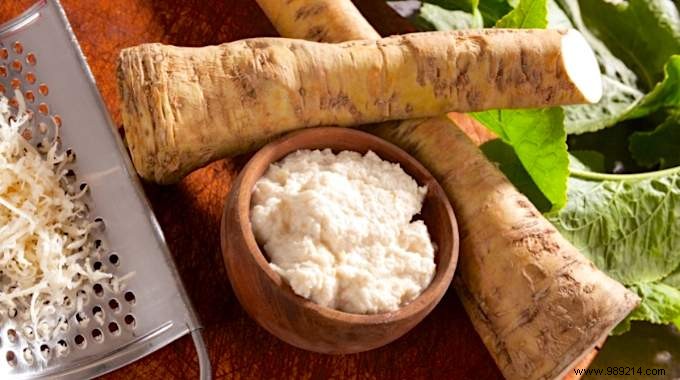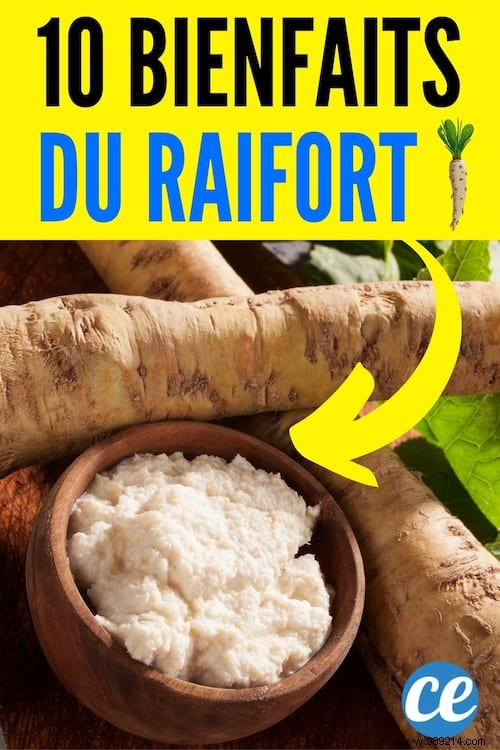
Do you know the benefits of horseradish?
It's an old vegetable a little forgotten whose virtues are nevertheless numerous.
It is also called German mustard or horse radish.
It is often confused with wasabi because of its spicy and pungent taste.
But it is a full-fledged root of the Brassicaceae family. It comes from Eastern Europe and Asia Minor.
Its medicinal virtues were already known among the Greeks, the Romans and they were also appreciated in the Middle Ages.
Here are 10 health benefits of horseradish that no one knows about :

This root effectively fights against digestive disorders.
If your intestinal transit is slowing down, horseradish can come to your aid.
Indeed, it improves intestinal transit and helps digestion , because it makes fatty foods more digestible.
Know that it decreases intestinal gas and that it also has a slight laxative effect .
And the icing on the cake... it cleans your intestines !
It also has depurative properties that clean the intestines and eliminate parasites. If you are considering a detox, it is ideal.
Horseradish is a concentrate of vitamin C.
In addition, it has the ability to liquefy secretions .
This makes it a valuable ally in reducing the symptoms of sinusitis and bronchitis.
Why ? Quite simply because it helps to decongest the bronchial tubes .
If you have the nose, a little advice:season your dish with horseradish and add a few drops of lemon.
You will quickly feel better.
Horseradish is rich in allicin and sinigrin.
They are two active compounds with antibiotic properties.
Thanks to these elements, horseradish has a bactericidal effect. It significantly relieves urinary tract infections.
It also has a diuretic effect which makes it easier to eliminate the bacteria responsible for urinary tract infections.
It is one of the best known and oldest medicinal virtues of horseradish.
Its properties to soothe joint pain due to osteoarthritis or arthritis have been recognized since the Middle Ages.
To relieve joint pain, poultices are made from it.
For this, the root is grated and mixed with a little water to make a paste. Then it is applied directly to the skin.
It's the same principle to relieve itching due to insect bites .
But that's not all...
Mosquitoes, spiders, wasps, horseflies...
Their bites not only itch, but they also cause an unpleasant burning sensation.
A poultice of horseradish helps soothe the itching and burning sensation.
Just grate some horseradish and mix it with water. Apply this poultice to the pimple for quick relief.
Do you know that horseradish is richer in vitamin C than orange? Surprising isn't it?
And very useful to fight against states of fatigue. It is very effective in strengthening our immune system.
Think about it when the first cold weather approaches!
It was not without reason that it was used to combat scurvy. Its effects against this disease have since been demonstrated.
This disease, which often affected sailors and prisoners, is the consequence of a significant lack of vitamin C.
To take advantage of these benefits, simply add it to your diet.
Horseradish is also known for its analgesic and anti-inflammatory properties.
Taken as a mouthwash, it can relieve pain caused by mouth ulcers.
Used as a poultice or added to your diet, horseradish also has the ability to improve and stimulate blood circulation .
It also helps regulate blood pressure.
As it has an antibacterial role, eating horseradish can limit the proliferation of bacteria in the mouth.
It can also be used as a mouthwash.
In any case, it cleanses the mouth, eliminating the causes of bad breath and protect the teeth .
We have seen that horseradish is an effective bactericide in particular thanks to the allicin it contains in large quantities.
It is a compound that is also found in garlic.
It is thanks to these properties that it can fight against Escherichia coli bacteria or even against staphylococcus aureus.
Horseradish is very rich in vitamin C, B2, B2, B6 and minerals (magnesium, calcium, phosphorus, iron).
In addition, we find among its components sinigrin .
It's the sinigrin that gives it its pungent taste.
Sinigrin is a glucosinolate also found in radishes, cabbage, mustard...
In particular, it has an anti-inflammatory action.
Horseradish also has a high concentration of allicin which is also present in garlic or leeks.
This sulfur compound has many virtues.
In particular, it is considered to have antibacterial, antiseptic and anti-inflammatory properties .
It is even said that it can fight against cancer. But these effects are not yet proven in humans.
And all these virtues are concentrated in a single vegetable:horseradish!
It would be a shame to deprive yourself of it!

There are a thousand and one ways to enjoy all the goodness of horseradish.
- If you have a juicer, you can make horseradish juice , at a rate of 20 g per day. It also delicately enhances tomato juice.
- It can be grated to make poultices .
- But it can also simply be used daily in the kitchen as a condiment .
It perfectly replaces mustard on a daily basis thanks to its peppery and strong flavors.
You can also put it in a vinaigrette, sauce or mayonnaise to enhance the taste.
It can be grated and mixed with red beets (the chrein in the Jewish tradition).
It can also accompany carrots, tomatoes or red cabbage . It's delicious!
You probably know that the English make their famous horseradish sauce which accompanies the roast beef. It's a classic!
But that's not all... It can also enhance an omelet , as in Italy (the rafenata).
In Austria or Germany, it simply accompanies meat and fish to raise them.
In the United States, it is used in sauce, especially in fast foods. To be tested urgently in a homemade burger!
Attention, it is recommended not to cook the horseradish .
I insist on this point, because it would lose all its medicinal properties and taste qualities.
Which would still be a shame!
Wondering how to prepare horseradish? It's very easy!
You have to start by peeling it with a peeler, as you would with a carrot.
Then use a kitchen grater to finely grate it.
Know that you should not eat the heart of the horseradish. This one is way too hard!
Fresh, horseradish will keep for several months in a perforated plastic bag in the vegetable drawer.
But once you've grated it, you have to eat the horseradish right away .
Otherwise, it loses its flavor and benefits.
You cannot therefore keep it in an airtight plastic or glass box.
Know that you can freeze it, but then it will lose its spicy taste.
The horseradish season runs from September to March. So it's a good time to buy it fresh.
You can find it in the vegetable section supermarkets like Auchan, Leclerc, Carrefour or in Biocoop.
Note that you can also buy pickled horseradish in vinegar in a jar or ground horseradish. Sometimes it's easier!
It is then in the condiments section .
If you prefer to buy fresh horseradish, you need to know some tips to choose it well .
It comes in the form of a slightly crooked root, usually with leaves.
If there are leaves, they must be very green . The root, it, must not be damaged or have stains . It should also be firm .
Horseradish is of course to be avoided in people who have an allergy with horseradish or one of its ingredients.
pregnant women or who are breastfeeding should also avoid horseradish.
Because the glucosinates present in this root can represent a risk of toxicity in breast milk or the placenta.